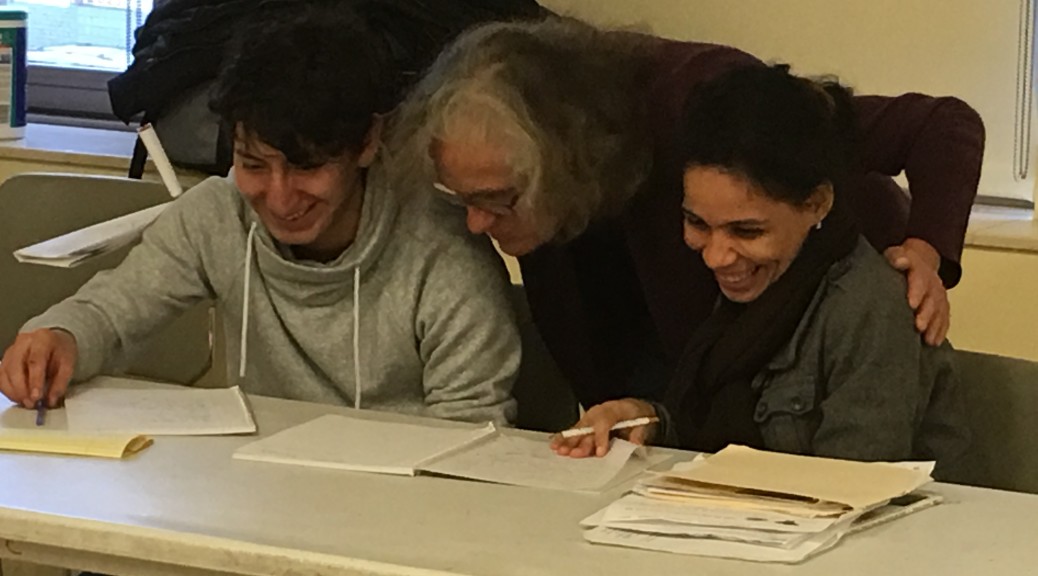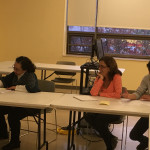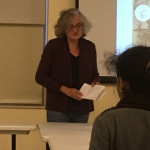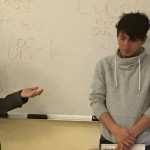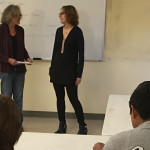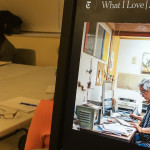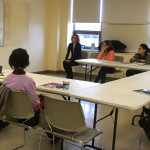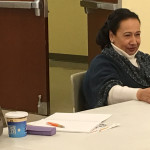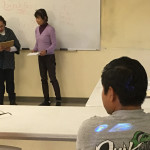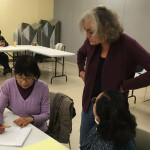Our first English class was held at the library in Long Island City. We introduced ourselves with basic information about where we are from and how long we have lived in America. Students then broke into groups of two and did more in depth interviews of each others using what, when, why, where and how question words. They learned more details about their partners life such as hobbies, favorites foods as well as why they were taking English class. Then they introduced each other. After classroom introductions we read about the life of artist Zhang Hongtu. The students then answered question words about his life, Where he is from? When did he come to America?. We also looked at the early work of Zhang Hongtu done when he was a student in China. This work included the line drawing entitled Break Time and the painting Still Life. A quote from Zhang Hongtu is particularly relevant for the allowing the students to develop their personal interpretation of Zhang Hongtu’s work as well as the work of other artists in the museum. “Misunderstanding is acceptable. . . . . . you can think this way or that. I just give you a chance to think, feel a different way with this image.” Artists brainstormed what these early pictures by Hongtu meant to them.
Text that was studied and read during the first class:
(REVISED FOR ESOL STUDENTS FROM THE ONLINE TEXT BY GUEST CURATOR LUCHIA MEIHUA LEE)
Zhang Hongtu is an artist from mainland China. Zhang helps people look at and understand the world around them by showing connections between cultures. He has lived in New York since 1982. He uses different types of subject matter and styles in his work.
This exhibit includes pieces from his days as a student in China in the late 1950’s up until the present day. More than 90 objects are included in this exhibit. The earliest work in this exhibit dates from Zhang’s art studies as a young man in Beijing and follow his life through Chairman Mao Zedong’s Cultural Revolution. As Muslims, Zhang and his family suffered badly during Mao’s rule. Zhang uses his childhood experience from youth to criticize systems of power today.
Coming to the U.S. in 1982 was a positive step for Zhang’s creative expression, but living in a new place had its own challenges. Many pieces from this period, including A Walking Man (1983-4) and Fish (1985), made while Zhang studied at the Art Students League, show a darker mood. Other art that he made at this time show Zhang’s ability to combine materials and cultural signs. Soy Sauce Calligraphy (1985) is a remake of a sweatshop “help wanted” ad – something quite common to New York’s Chinatown in the 1980’s. These pieces were made in the style of traditional Chinese calligraphy. In another group of work he uses pages from the New York Times to make paintings that combined headlines of American prosperity with images of the difficult reality of immigrant life.
Zhang is mischievous and uses his personal history along with his study of traditional Chinese and Western art history to surprise his viewers. The “political pop” work from his Mao Series (1987-ongoing) is an example of how Zhang uses surprise and humor in his work. In the Mao Series that he began in 1987 and continues working on today, Zhang gives us an experience of seeing the image of Mao everywhere around us – from the front of a Quaker Oats canister to his silhouette cut out of burlap. Mao’s image is a reminder that the experience of the Chairman’s absolute power was a part of the daily lives of Chinese citizens.
In The Big Red Door (2015) and Zhang’s large scale photo mural The Great Wall with Gates II Zhang uses iconic Chinese architecture to make statements that are timeless and true for everyone. In The Big Red Door large nails show entryways into Beijing’s palace, the Forgotten City. Zhang makes fun of these symbols of power by replacing the nail heads with phalluses. He comments on patriarchal power that continues in many different countries today. In the Great Wall with Gates II Zhang takes a world cultural monument built by a tyrant as a sealed border and makes it useless by cutting holes in it.
Zhang combines opposites such as east and west, high and low, and past and present in his work. He frees his viewers to look at the world in a new way by taking old images and putting them in new contexts. In his interpretation of European artists like Van Gogh and Picasso, his remakes of the ancient waterscapes of the Chinese master Ma Yuan and his combination of historical Chinese icons with American consumer products Zhang allows us to contemplate unexpected combinations and their relevance in today’s world.
*_ Next week we will continue looking at the work of Zhang Hongtu as well as introducing another artist from the Queens Museum.
Nuestra primera clase de Inglés se llevó a cabo en la biblioteca de Long Island City. Nos presentamos a nosotros mismos con la información básica acerca de dónde somos y cuánto tiempo hemos vivido en América. Luego, los estudiantes se dividieron en grupos de a dos e hicieron unos a otros algunas preguntas en profundidad, usando las palabras en ingles ( what ) qué, ( when ) cuándo, ( why ) por qué, ( Where ) dónde y ( how ) cómo que son las principales palabras de interrogación. Compartieron detalles de sus vidas, tales como sus comidas favoritas , que los motiva a tomar esta clase de Inglés. Luego se presentaron entre sí. Después de las presentaciones leimos sobre la vida del artista Zhang Hongtu. Luego de lo cual respondieron a las palabras interrogativas en ingles ( what, how, where,etc.) aprendidas previamente armando oraciones interrogativas sobre sus vidas, ¿ de dónde es? ¿Cuándo llegó a América ? Acto seguido, revisamos en imagenes los primeros trabajos de Zhang Hongtu, aquellos hechos cuando era aun estudiante en China. Esta parte de la clase incluyó reflexiones sobre el trabajo titulado “Tiempo de la rotura” y ” Naturaleza muerta”. Pusimos atencion a una cita de Zhang Hongtu que es particularmente relevante para permitir a los estudiantes desarrollar una interpretación personal su obra así como de otros artistas cuyas trabajos estaran tambien presentes en QM. “El malentendido es aceptable…… Se puede pensar de esta o aquella manera. Yo sólo brindo la oportunidad de pensar y sentir de una manera diferente con mis imagenes.”
La semana que viene vamos a seguir mirando el trabajo de Zhang Hongtu, así como la introducción de otro artista del Museo de Queens.

